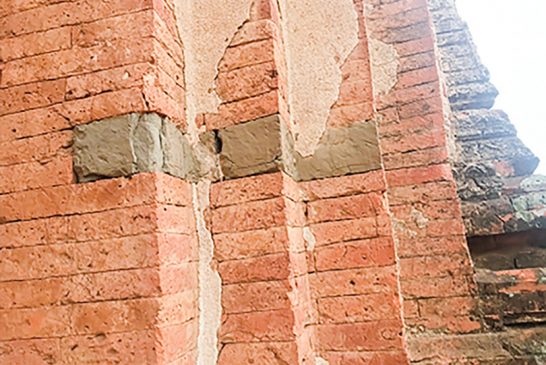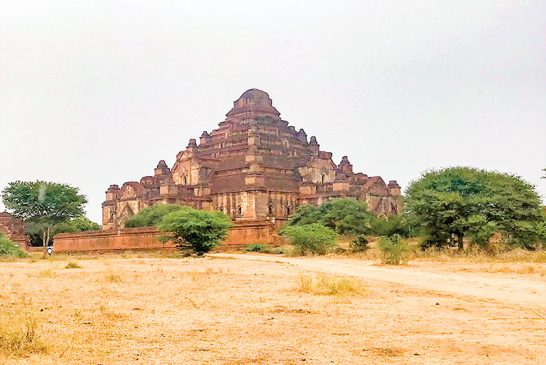Than Htun (Myanmar Geosciences Society)
(Continued from article on 18 Jan)
There were also tamarind trees along the space taken up by this long line of people to provide shelter from the sun and the tree must have been larger enough to give necessary shade (Dr. Ma Tin Win, 2009). There have been some scholars who maintain that there is no evidence to claim that the Shwezigon was built of stone or that this pagoda is the meritorious deed of King Anawrahta. For many years although history books mentioned that the Shwezigon was built by King Anawrahta the issue remained unsolved for there was no definite knowledge about it. Most history texts also said that Anawratha did not live long enough to see the completion of his work of merit and that he died after three of the terraces had been built and the relics just enshrined. It remained an open question for thousands of years due to lack of evidence. However, when a violent earthquake occurred in Bagan and its environs on 8th July 1975, its tremors revealed hidden historical evidence.
Due to the intensity of the tremors large chunks of concrete as well as gold were dislodged and it was then discovered that the great pagoda had been built entirely of stone bricks from the base, and right up to the level of the decorative inverted lotus and spreading lotus encircling it. In renovating the pagoda after the earthquake the authorities left a two foot square space uncovered at the base on the south-eastern side of the pagoda as indubitable evidence that it had been built of stone bricks. The bricks in the space uncovered had been so skillfully that it is impossible to insert even a pin between two bricks.

Kyaukgu U-min Cave
The cave was built of bricks and rocks and was thus called the Kyaukgu U-min (Rock Cave Tunnel). This is one of the three structures of Bagan built with rocks. Another one was the Sekku Taik near Myakan that can no longer be found today and the third is the Nan Hpaya still standing prominently today. Kyaukgu U-min is therefore one of the more prominent grotto pagodas of Bagan.
There are three terraces in Kyaukgu U-min. Facing the gully, a huge Holy Image with a spacious prayer hall sits facing the entrance archway. At the back of the Image are tunnels. The lower storey of the front part of the structure was built of rocks and the upper storey built of bricks. On the inside wall of the upper storey are niches where there probably were Holy Images originally. The Kyaukgu U-min is located in a peaceful and quiet area suitable used as a recluse for ascetics. Venerable monks had therefore dwelled there since the days of Bagan Period. The place still is very suitable for those who want to meditate (Paragu, 2013).
The Nan Hyapa
When King Anawrahta waged battel against the kingdom of Thaton and he brought back King Manuha to Bagan as captive and kept him under restraint. The Nan Hpaya was built for worship in the locale of King Manuha’s residence, hence the name, Nan Hpaya or Palace Pagoda. It could be ascertained that the location of the Nan Hpaya is actually the place where Manuha was held captive, then the king’s residence and the Manuha Temple built by him is just within hailing distance. Some historians maintain that Nan Hpaya was also built by King Manuha. It would appear that Manuha had been permitted freedom to certain extent, for not only was he able to build the Manuha Temple, he was also able to build a rather palatial pagoda for worship in the area of his residence. There is a kind of throne room in the Nan Hpaya. Some historians however, are of the opinion that Nan Hpaya was built not by Manuha but by his grandson, Naga Thaman. But some others contend that Naga Thaman was great grandson and not the grandson of King Manuha as some had claimed (Paragu, 2013).
The Nan Hpaya’s foundation is squarish in design and is a vaulted temple with the façade of the main prayer chamber facing east. Due to its personalized architectural design it differs greatly from that of the other stupas and temples. The exterior walls are entirely lined with stone bricks. In Bagan, there now remain only two temples with their entire walls lined with stone bricks. One is the Nan Hpaya and the other is the Kyaukgu U-min (Stone Cave temple). You will gaze upon with wonder the marvelous stone sculpture of the Bagan Era.
These stone sculptures have withstood the assault of the elements continuously for 890 years, thus attesting to the artistic excellent of Bagan era stone sculpture. Here again could be seen the best samples of stone sculpture of which the most fascinating are the four large pillars. These stone pillars had been built with arches and on each of the sixteen sides of these pillars had been sculptured the four-faced Brahma holding triangular Kanoke flowers and lotus blooms (Paragu, 2013).
Lokananda chedi
Furthermore, after the author review the construction of Lokananda chedi it is mentioned that the footprint of the Buddha in stone now seen at the Bagan Museum was found on the platform of the Lokananda chedi. The lower part of Lokananda chedi is built of sandstone and the upper level of bricks. There are so many fascinating and interesting facts and features of Bagan that in writing about it one has to be extra careful not to inadvertently leave out what is important.
Dammayangyi
Dammayangyi Pagoda is the most intriguing and interesting of all the pagodas in the Bagan vicinity. From which ever direction one looks, there is the Dammayangyi looming up towards the sky. It is certainly the largest pagoda in the whole of Bagan. Originally there were two ambulatory corridors around the central square block of the building but the entire inner corridor has been filled up with bricks, and the entrance and archways from the outer to the inner corridor have for some unknown reason, been sealed off with bricks. The author excitedly observed left and right sides of the arch wall has been laid three (8inch x 1ft x1ft) pale green sandstone bricks on both sides which are about 6ft high. Those sandstones are identical to the sandstone bricks of Shwezigon Pagoda. Therefore, it is reasonable to assume that the Tuyin Taung sandstone was used for many buildings and pagodas during Bagan Dynasty before or after building Shwezigon Temple. The relationship between mother Earth and human beings are inevitable since prehistoric days and it is eternal relationship between man and Earth.
References:
1. Swezigon Pagoda Trustees,1994. A Guide to Shwezigon Pagoda
2. Dr. Ma Tin Win, 2009. The Great donors of Bagan and Their Religious Monuments
3. Paragu, 2013. The Bagan Wayfarer
4. H.L.Chhibber, 1934. The Geology of Burma



